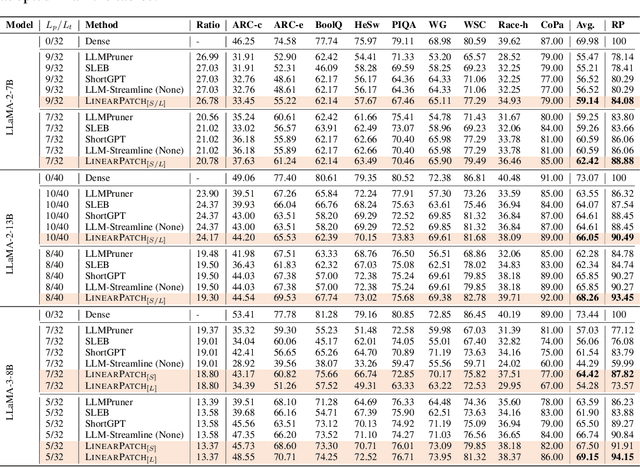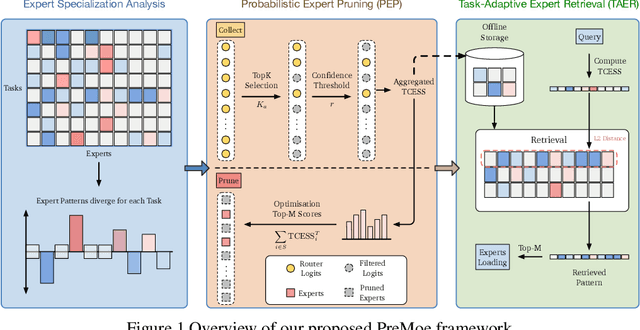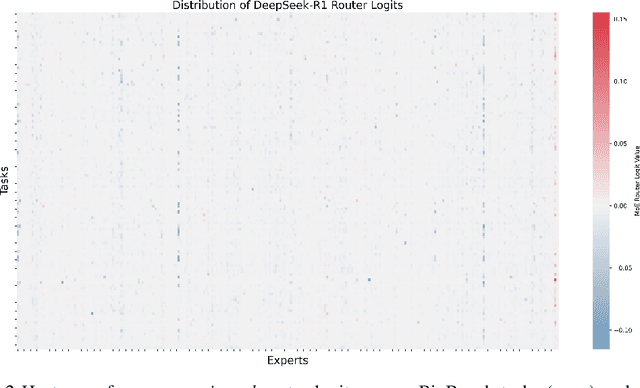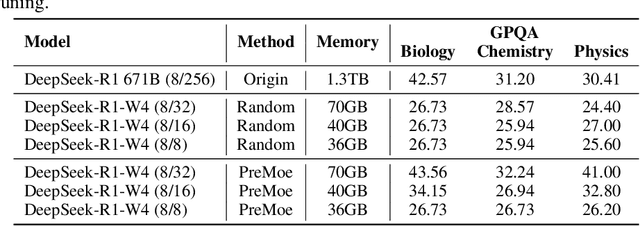Xianzhi Yu
and Other Contributors
EAQuant: Enhancing Post-Training Quantization for MoE Models via Expert-Aware Optimization
Jun 16, 2025Abstract:Mixture-of-Experts (MoE) models have emerged as a cornerstone of large-scale deep learning by efficiently distributing computation and enhancing performance. However, their unique architecture-characterized by sparse expert activation and dynamic routing mechanisms-introduces inherent complexities that challenge conventional quantization techniques. Existing post-training quantization (PTQ) methods struggle to address activation outliers, router consistency and sparse expert calibration, leading to significant performance degradation. To bridge this gap, we propose EAQuant, a novel PTQ framework tailored for MoE architectures. Our method systematically tackles these challenges through three key innovations: (1) expert-aware smoothing aggregation to suppress activation outliers and stabilize quantization, (2) router logits distribution alignment to preserve expert selection consistency post-quantization, and (3) expert-level calibration data balance to optimize sparsely activated experts. Extensive experiments across W4A4 and extreme W3A4 quantization configurations demonstrate that EAQuant significantly outperforms existing methods, achieving average score improvements of 1.15 - 2.28% across three diverse MoE architectures, with particularly pronounced gains in reasoning tasks and robust performance retention under aggressive quantization. By integrating these innovations, EAQuant establishes a new state-of-the-art for high-precision, efficient MoE model compression. Our code is available at https://github.com/darren-fzq/EAQuant.
A Simple Linear Patch Revives Layer-Pruned Large Language Models
May 30, 2025



Abstract:Layer pruning has become a popular technique for compressing large language models (LLMs) due to its simplicity. However, existing layer pruning methods often suffer from significant performance drops. We identify that this degradation stems from the mismatch of activation magnitudes across layers and tokens at the pruning interface. To address this, we propose LinearPatch, a simple plug-and-play technique to revive the layer-pruned LLMs. The proposed method adopts Hadamard transformation to suppress massive outliers in particular tokens, and channel-wise scaling to align the activation magnitudes. These operations can be fused into a single matrix, which functions as a patch to bridge the pruning interface with negligible inference overhead. LinearPatch retains up to 94.15% performance of the original model when pruning 5 layers of LLaMA-3-8B on the question answering benchmark, surpassing existing state-of-the-art methods by 4%. In addition, the patch matrix can be further optimized with memory efficient offline knowledge distillation. With only 5K samples, the retained performance of LinearPatch can be further boosted to 95.16% within 30 minutes on a single computing card.
Pangu Pro MoE: Mixture of Grouped Experts for Efficient Sparsity
May 28, 2025Abstract:The surgence of Mixture of Experts (MoE) in Large Language Models promises a small price of execution cost for a much larger model parameter count and learning capacity, because only a small fraction of parameters are activated for each input token. However, it is commonly observed that some experts are activated far more often than others, leading to system inefficiency when running the experts on different devices in parallel. Therefore, we introduce Mixture of Grouped Experts (MoGE), which groups the experts during selection and balances the expert workload better than MoE in nature. It constrains tokens to activate an equal number of experts within each predefined expert group. When a model execution is distributed on multiple devices, this architectural design ensures a balanced computational load across devices, significantly enhancing throughput, particularly for the inference phase. Further, we build Pangu Pro MoE on Ascend NPUs, a sparse model based on MoGE with 72 billion total parameters, 16 billion of which are activated for each token. The configuration of Pangu Pro MoE is optimized for Ascend 300I Duo and 800I A2 through extensive system simulation studies. Our experiments indicate that MoGE indeed leads to better expert load balancing and more efficient execution for both model training and inference on Ascend NPUs. The inference performance of Pangu Pro MoE achieves 1148 tokens/s per card and can be further improved to 1528 tokens/s per card by speculative acceleration, outperforming comparable 32B and 72B Dense models. Furthermore, we achieve an excellent cost-to-performance ratio for model inference on Ascend 300I Duo. Our studies show that Ascend NPUs are capable of training Pangu Pro MoE with massive parallelization to make it a leading model within the sub-100B total parameter class, outperforming prominent open-source models like GLM-Z1-32B and Qwen3-32B.
Faster and Better LLMs via Latency-Aware Test-Time Scaling
May 26, 2025Abstract:Test-Time Scaling (TTS) has proven effective in improving the performance of Large Language Models (LLMs) during inference. However, existing research has overlooked the efficiency of TTS from a latency-sensitive perspective. Through a latency-aware evaluation of representative TTS methods, we demonstrate that a compute-optimal TTS does not always result in the lowest latency in scenarios where latency is critical. To address this gap and achieve latency-optimal TTS, we propose two key approaches by optimizing the concurrency configurations: (1) branch-wise parallelism, which leverages multiple concurrent inference branches, and (2) sequence-wise parallelism, enabled by speculative decoding. By integrating these two approaches and allocating computational resources properly to each, our latency-optimal TTS enables a 32B model to reach 82.3% accuracy on MATH-500 within 1 minute and a smaller 3B model to achieve 72.4% within 10 seconds. Our work emphasizes the importance of latency-aware TTS and demonstrates its ability to deliver both speed and accuracy in latency-sensitive scenarios.
MoESD: Unveil Speculative Decoding's Potential for Accelerating Sparse MoE
May 26, 2025Abstract:Large Language Models (LLMs) have achieved remarkable success across many applications, with Mixture of Experts (MoE) models demonstrating great potential. Compared to traditional dense models, MoEs achieve better performance with less computation. Speculative decoding (SD) is a widely used technique to accelerate LLM inference without accuracy loss, but it has been considered efficient only for dense models. In this work, we first demonstrate that, under medium batch sizes, MoE surprisingly benefits more from SD than dense models. Furthermore, as MoE becomes sparser -- the prevailing trend in MoE designs -- the batch size range where SD acceleration is expected to be effective becomes broader. To quantitatively understand tradeoffs involved in SD, we develop a reliable modeling based on theoretical analyses. While current SD research primarily focuses on improving acceptance rates of algorithms, changes in workload and model architecture can still lead to degraded SD acceleration even with high acceptance rates. To address this limitation, we introduce a new metric 'target efficiency' that characterizes these effects, thus helping researchers identify system bottlenecks and understand SD acceleration more comprehensively. For scenarios like private serving, this work unveils a new perspective to speed up MoE inference, where existing solutions struggle. Experiments on different GPUs show up to 2.29x speedup for Qwen2-57B-A14B at medium batch sizes and validate our theoretical predictions.
L-MTP: Leap Multi-Token Prediction Beyond Adjacent Context for Large Language Models
May 23, 2025Abstract:Large language models (LLMs) have achieved notable progress. Despite their success, next-token prediction (NTP), the dominant method for LLM training and inference, is constrained in both contextual coverage and inference efficiency due to its inherently sequential process. To overcome these challenges, we propose leap multi-token prediction~(L-MTP), an innovative token prediction method that extends the capabilities of multi-token prediction (MTP) by introducing a leap-based mechanism. Unlike conventional MTP, which generates multiple tokens at adjacent positions, L-MTP strategically skips over intermediate tokens, predicting non-sequential ones in a single forward pass. This structured leap not only enhances the model's ability to capture long-range dependencies but also enables a decoding strategy specially optimized for non-sequential leap token generation, effectively accelerating inference. We theoretically demonstrate the benefit of L-MTP in improving inference efficiency. Experiments across diverse benchmarks validate its merit in boosting both LLM performance and inference speed. The source code will be publicly available.
PreMoe: Lightening MoEs on Constrained Memory by Expert Pruning and Retrieval
May 23, 2025



Abstract:Mixture-of-experts (MoE) architectures enable scaling large language models (LLMs) to vast parameter counts without a proportional rise in computational costs. However, the significant memory demands of large MoE models hinder their deployment across various computational environments, from cloud servers to consumer devices. This study first demonstrates pronounced task-specific specialization in expert activation patterns within MoE layers. Building on this, we introduce PreMoe, a novel framework that enables efficient deployment of massive MoE models in memory-constrained environments. PreMoe features two main components: probabilistic expert pruning (PEP) and task-adaptive expert retrieval (TAER). PEP employs a new metric, the task-conditioned expected selection score (TCESS), derived from router logits to quantify expert importance for specific tasks, thereby identifying a minimal set of critical experts. TAER leverages these task-specific expert importance profiles for efficient inference. It pre-computes and stores compact expert patterns for diverse tasks. When a user query is received, TAER rapidly identifies the most relevant stored task pattern and reconstructs the model by loading only the small subset of experts crucial for that task. This approach dramatically reduces the memory footprint across all deployment scenarios. DeepSeek-R1 671B maintains 97.2\% accuracy on MATH500 when pruned to 8/128 configuration (50\% expert reduction), and still achieves 72.0\% with aggressive 8/32 pruning (87.5\% expert reduction). Pangu-Ultra-MoE 718B achieves 97.15\% on MATH500 and 81.3\% on AIME24 with 8/128 pruning, while even more aggressive pruning to 4/64 (390GB memory) preserves 96.95\% accuracy on MATH500. We make our code publicly available at https://github.com/JarvisPei/PreMoe.
TrimR: Verifier-based Training-Free Thinking Compression for Efficient Test-Time Scaling
May 22, 2025Abstract:Large Reasoning Models (LRMs) demonstrate exceptional capability in tackling complex mathematical, logical, and coding tasks by leveraging extended Chain-of-Thought (CoT) reasoning. Test-time scaling methods, such as prolonging CoT with explicit token-level exploration, can push LRMs' accuracy boundaries, but they incur significant decoding overhead. A key inefficiency source is LRMs often generate redundant thinking CoTs, which demonstrate clear structured overthinking and underthinking patterns. Inspired by human cognitive reasoning processes and numerical optimization theories, we propose TrimR, a verifier-based, training-free, efficient framework for dynamic CoT compression to trim reasoning and enhance test-time scaling, explicitly tailored for production-level deployment. Our method employs a lightweight, pretrained, instruction-tuned verifier to detect and truncate redundant intermediate thoughts of LRMs without any LRM or verifier fine-tuning. We present both the core algorithm and asynchronous online system engineered for high-throughput industrial applications. Empirical evaluations on Ascend NPUs and vLLM show that our framework delivers substantial gains in inference efficiency under large-batch workloads. In particular, on the four MATH500, AIME24, AIME25, and GPQA benchmarks, the reasoning runtime of Pangu-R-38B, QwQ-32B, and DeepSeek-R1-Distill-Qwen-32B is improved by up to 70% with negligible impact on accuracy.
Pangu Ultra MoE: How to Train Your Big MoE on Ascend NPUs
May 07, 2025Abstract:Sparse large language models (LLMs) with Mixture of Experts (MoE) and close to a trillion parameters are dominating the realm of most capable language models. However, the massive model scale poses significant challenges for the underlying software and hardware systems. In this paper, we aim to uncover a recipe to harness such scale on Ascend NPUs. The key goals are better usage of the computing resources under the dynamic sparse model structures and materializing the expected performance gain on the actual hardware. To select model configurations suitable for Ascend NPUs without repeatedly running the expensive experiments, we leverage simulation to compare the trade-off of various model hyperparameters. This study led to Pangu Ultra MoE, a sparse LLM with 718 billion parameters, and we conducted experiments on the model to verify the simulation results. On the system side, we dig into Expert Parallelism to optimize the communication between NPU devices to reduce the synchronization overhead. We also optimize the memory efficiency within the devices to further reduce the parameter and activation management overhead. In the end, we achieve an MFU of 30.0% when training Pangu Ultra MoE, with performance comparable to that of DeepSeek R1, on 6K Ascend NPUs, and demonstrate that the Ascend system is capable of harnessing all the training stages of the state-of-the-art language models. Extensive experiments indicate that our recipe can lead to efficient training of large-scale sparse language models with MoE. We also study the behaviors of such models for future reference.
Quantization Hurts Reasoning? An Empirical Study on Quantized Reasoning Models
Apr 07, 2025Abstract:Recent advancements in reasoning language models have demonstrated remarkable performance in complex tasks, but their extended chain-of-thought reasoning process increases inference overhead. While quantization has been widely adopted to reduce the inference cost of large language models, its impact on reasoning models remains understudied. In this study, we conduct the first systematic study on quantized reasoning models, evaluating the open-sourced DeepSeek-R1-Distilled Qwen and LLaMA families ranging from 1.5B to 70B parameters, and QwQ-32B. Our investigation covers weight, KV cache, and activation quantization using state-of-the-art algorithms at varying bit-widths, with extensive evaluation across mathematical (AIME, MATH-500), scientific (GPQA), and programming (LiveCodeBench) reasoning benchmarks. Our findings reveal that while lossless quantization can be achieved with W8A8 or W4A16 quantization, lower bit-widths introduce significant accuracy risks. We further identify model size, model origin, and task difficulty as critical determinants of performance. Contrary to expectations, quantized models do not exhibit increased output lengths. In addition, strategically scaling the model sizes or reasoning steps can effectively enhance the performance. All quantized models and codes will be open-sourced in https://github.com/ruikangliu/Quantized-Reasoning-Models.
 Add to Chrome
Add to Chrome Add to Firefox
Add to Firefox Add to Edge
Add to Edge